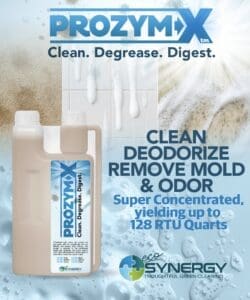Understanding the Science of Cleaning + Odor Neutralization
When we clean, we’re not just removing what we can see — we’re trying to eliminate the invisible molecules that cause odor. While fragrances and masking sprays may create the illusion of cleanliness, true odor removal requires a scientific approach that neutralizes or breaks down the source of the smell at a molecular level.
At Synergy Green Clean, two scientifically advanced cleaning systems accomplish this — each optimized for different conditions:
- Enzyme + Detergent Cleaning (PROZYM-X)
- Chlorine Dioxide + Detergent Cleaning (Envirotab + Soil Break)
Both methods clean and deodorize simultaneously, but they work in very different ways — and knowing when to use each can make all the difference between a temporary fix and a lasting solution.
1. Enzyme + Detergent Cleaning (PROZYM-X): Biological Power for Organic Odors

Enzyme cleaning is nature’s way of solving tough odor problems — and it’s particularly effective when the contaminants are organic and deeply embedded.
How it works:
Enzymes are specialized proteins that act as catalysts, speeding up chemical reactions that break down complex organic matter into simpler, odorless compounds. PROZYM-X uses a balanced mix of enzymes and detergents designed to:
- Digest organic waste such as urine, feces, vomit, sweat, or food residues
- Penetrate porous surfaces like wood, grout, carpet backing, or subflooring
- Continue working after application — even after visible soil is gone
Best use cases:
- Cat or dog urine in wood flooring or subflooring
- Body odor and sweat in fabrics or upholstery
- Food spills that seeped into grout lines or under tiles
| Scenario | Challenge | Best Method | Why It Works |
|---|---|---|---|
| Pet urine in hardwood flooring | Odor and stain absorbed into wood fibers | PROZYM-X | Enzymes digest odor-causing organic molecules deep within the wood |
| Old milk spill on carpet backing | Organic residue producing sour smell | PROZYM-X | Breaks down protein and fat residues at their molecular level |
| Musty odor in damp basement carpet | Hidden organic growth | PROZYM-X | Continues to work as surfaces dry, preventing regrowth |
Scientific takeaway:
Enzyme cleaning works biologically, not chemically — it dismantles the odor source itself rather than oxidizing it. It’s ideal when the problem is living or once-living (organic) and has penetrated deep into porous materials.
2. ClO₂ + Detergent Cleaning (Envirotab + Soil Break): Oxidative Power for Surface Odors and Heavy Soils
When the odor source is more environmental — smoke, soot, mildew, or grease — an oxidizing cleaner is the smarter approach.

How it works:
Chlorine dioxide (ClO₂) is a powerful oxidizing agent that reacts with odor molecules by transferring oxygen atoms, effectively neutralizing them. When used in combination with Soil Break, a concentrated detergent and degreaser containing sodium carbonate, the process becomes both chemical and mechanical:
- ClO₂ neutralizes volatile odor compounds at a molecular level
- Soil Break breaks up oils, carbon buildup, and greasy residues
- Sodium carbonate (core ingredient in Soil Break) buffers the solution, ensuring a slow release of ClO₂ gas — giving it extended contact time for odor removal
Best use cases:
- Cigarette smoke or tobacco residue on hard surfaces and walls
- Cooking grease and burned-on kitchen odors
- Mildew or microbial odor on bathroom tile or grout
- Fire or smoke residue on building materials
| Scenario | Challenge | Best Method | Why It Works |
|---|---|---|---|
| Smoke film on painted walls | Soot, nicotine, and tar residue | Envirotab + Soil Break | ClO₂ oxidizes odor molecules while Soil Break emulsifies grease |
| Greasy kitchen backsplash | Layers of oil and burnt food odors | Envirotab + Soil Break | Sodium carbonate cuts grease while ClO₂ neutralizes odor |
| Mildew odor on shower grout | Biofilm and mineral buildup | Envirotab + Soil Break | Oxidation eliminates odor while detergent removes buildup |
Scientific takeaway:
ClO₂ cleaning works chemically by oxidation — it neutralizes odor-causing molecules and sanitizes surfaces. It’s fast, powerful, and perfect for removing surface-level odor sources and tough residues.
When to Use Each Method
| Odor Source Type | Surface Type | Recommended Method | Result |
|---|---|---|---|
| Organic (urine, food, waste) | Porous (wood, carpet, grout) | PROZYM-X Enzyme + Detergent | Deep odor digestion and residual cleaning |
| Inorganic (smoke, grease, mildew) | Non-porous (tile, walls, glass, metal) | Envirotab + Soil Break (ClO₂ + Detergent) | Rapid oxidation, soil breakdown, odor neutralization |
Real-World Examples:
-
Case 1: Cat Urine in Wood Flooring
After multiple cleanings with traditional detergents failed, a homeowner used PROZYM-X. The enzymatic activity penetrated beneath the finish into the wood grain, digesting the odor-causing compounds completely — not just masking them. -
Case 2: Kitchen Fire Residue and Odor
A restoration technician treated greasy walls and ceilings using Envirotab + Soil Break. Within hours, smoke odor was neutralized, and surfaces were bright and residue-free.
Synergy Green Clean’s Dual-System Advantage
At Synergy Green Clean, we offer both biological and chemical odor removal systems because every cleaning challenge is unique. Whether you’re battling deep organic contamination or heavy environmental residue, our scientifically balanced products give you the right tool for the job.
-
PROZYM-X → The biological enzyme cleaner for organic odors.
-
Envirotab + Soil Break → The oxidative cleaner for inorganic or surface-bound odors.
Conclusion: It's All About the Chemistry
Odor removal isn’t just about smell — it’s about chemistry.
By understanding whether your odor source is organic or inorganic, you can select the right scientific method to clean and neutralize it effectively. With enzyme-based PROZYM-X and ClO₂-powered Envirotab + Soil Break, you can clean deeper, deodorize smarter, and restore true freshness — naturally and scientifically.





